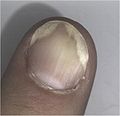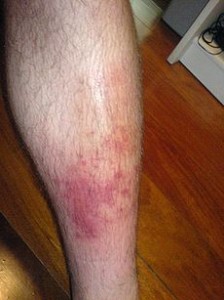The human skin is the largest organ of the organ system that protects the body from damages comprising the skin and appendages, and has multiple layers of ectodermal tissue and guards the underlying muscles, bones, ligaments and internal organs. The human skin color(skin pigmentation) varies among populations, and the skin type ranges from oily and dry skin. The two general types of skin are hairless skin(glabrous skin) and hairy skin. The palms and sole of the foot are reffered to as the “palmoplantar surfaces” or the glabrous skin part. Damaged skin cause by chemicals, accidents, surgery or deep wounds causes the scar in the skins.
1) Acne Vulgaris
Acne vulgaris is a common human skin diseases and ususally appears in adolescence, and sometimes continues to appear into adults. During the stage of puberty, the testosterone increases to both males and females and causes acne. Acne Vulgaris, are red-scaly skin (seborrhia), blackheads and whiteheads(comedones), pinheads (papiles), pimples and nodules (pustules, large papules) and scars.
Seborrhoeic Dermatitis (Wikipedia)
Comedones or Blackheads
Blackheads or comedones, is the medical term for open comedo, a yellowish or blackish bump or plug on the skin and a type of acne vulgaris. The pimple or closed comedo is called whiteheads, a follicle filled with sebum, but it lacks microscopic opening in the skin surface and the air cannot reach the follicle and not oxidized, it remained white in color.
2) Milium or Milia
Milium or milia also known as milk spot or an oil seed, is a keratin filled cyst that can appear just under the epidermis or roof of the mouth. Milia commonly appears on the newborn babies but it can appear in all ages. Commonly appears around the eyelids, nose or even genitalia and oftentimes mistaken as warts or STDs.
3) Warts
Warts are generally a small and rough usually appears on hands, fingers, foot sole or palms. The warts can be contagious disease caused by viral infections by human papillovirus, but considered harmless looks like cauliflower or blisters. There are various types of warts: common warts(verucca vulgaris), flat warts, filiform or digitate warts, genital warts or venerial warts, mosaic warts, periungual warts and plantar warts.
4) Onychomycosis
Onychomycosis also called “dermatophytic onychomycosis” or ringworm of the nail or “Tinea unguium”, means fungal infection of the nails. Toenails and fingernails are affected and half of the nails have abnormalities in features.
5) Nail Patella Syndrome (NPS)
Nail Patella syndrome (NPS) is a genetic disorder that results in small, poorly developed nails and kneecaps, but can also affect many other areas of the body such as the elbows, chest and hips as well. The name “nail patella syndrome” is very misleading, because it often affects other areas of the body and the production of proteins and reffered to as “iliac horn syndrome”, hereditary onychoostedysplasia, Fong’s disease or Turner-Kiser syndrome. Nail patella is inherited via autosomal dominancy.
Onychotillomania or Onyphagia
Onychotillomania is trying to tear the nails by picking constantly because of compulsive neurosis, while ‘onychopagia’, when a person bites their nails or scratch their skin or chew dermatillomania. Acoording to studies, it is a kind of psychiatric disorder like depressive neurosis, delusions of infestation and hypochondriasis.
Dermatillomania
Dermatillomania also known as “compulsive skin picking” or CSP, is an impulsive control disorder and self-injury by the urge to pick at own skin that resulted sometimes to skin damages. It can be also “compulsive body dysmorphic disorder” (BDD). A person with dermatillomania find skin-picking relieved from depressions or stress and the pain caused is bearable.
6) Black Hairy Tongue
Black hairy tongue or Lingua Villosa Nigra in Latin, is the spreading of papillae which are bumps on the tongue surfaces. When papillae is rubbed away by food but sometimes they grow longer than normal and makes the tongue looked hairy, and the extra tissues get stained by food or tobacco that makes it yellowish-brown or even black hairy tongue. Black hairy tongue is a common condition resulting from various elements that contributes to the disorder of the tongue from using large amount of antibiotics, chewing tobacco, radiation treatment to the head and neck and loss of tooth (food scraping the tongue).
7) Alopecia Areata (AA)
Alopecia Totallis (Wikipedia)

Matt Lucas (English comdian, screenwriter & TV actor of Little Britain) with Alopecia Universalis (Wikipedia)
Alopecia areata is the medical condition in which hair is lost from some or all areas of the body, especially the scalp. Bald spots on the scalp in the first stage, are called “spot baldness”, and the condition spread to the entire scalp and called “alopecia totalis”, or the entire epidrmis and called “alopecia universalis”. The loss of hair was believed to be an ‘autoimmune disorder’, but some believed that stress causes loss of hair. Alopecia universalis includes loss of eyebrows and eyelashes hairs, and the most severe case of alopecia areata, is alopecia universalis.
![]() Favus
Favus
Favus is a disease affecting the scalp, but sometimes it can appear on the ski or mucous membranes. It is characterized as yellowish, circular, cup-shaped crusts (Scutula) group in patches, and common cause is the growth of fungus and pathologically reaction of the tissues to the growth.
Dandruff
Dandruff or Pityriasis Simplex Capitillitii is not a chronic condition of the scalp and is the shedding of dead skin cells from the scalp. Dandruff sometimes is cause by frequent exposure from sunlight or heat, and cold temperature, and is normal for skin cells to die and flake off. It is a common scalp disorder but sometimes having dandruff can cause social esteem problems. Excessive perspiration and the climate have significant roles in the ‘pathogenesis’ of Pityriasis Simplex Capitillitii or dandruff.
9) Measles
Measles (Wikipedia)
Measles, also called Ruboela or Morbilli, is an infection of the respiratory system caused by a virus, “paramyxovirus” of the genus ‘Morbillivirus’. Fever, cough, runny nose, red eyes and masulapapukar, erythematous rashes are the symptoms of measles.
10) Grover’s Disease
Grover’s Disease advanced case (Wikipedia)
Grover’s disease also called “benign papular acantholytic dermatosis”, “Persistent Acantholytic dermatosis”, and “Transient Acantholytic dermatosis”, is a polymorphic, itchy(pruritic), papulovesicular dermatosis described histologically by acantholysis.
11) Psoriasis
Psoriasis (Wikipedia)
Psoriasis is a chronic skin disease, that occurs when the immune system have faulty appearance and speed up in growth cycle of the skin cells. Psoriasis is not contagious skin disease and have five types of Psoriasis skin disorders; guttate, inverse, plaque, erythrodermic and pustular.
12) Ringworm or Dermatophytosis
Ringworm or dermatophytosis is a skin disease caused by fungal infection most commonly affected are human skins. Tinea is a general term for skin mycosis fungi infection of ringworm, and usually considered a synonym. Ringworm can spread on animal pets like cats, sheep and catlles or any domesticated animals. Ringworm is a misnomer, since the condition is caused by fungi of several kinds of species and not by parasitic worms, and there are different kinds of fungi dermatophytosis or ringworm:
Athlete’s foot or also called “ringworm of the foot“, “Tinea Pedis” and “Hong Kong Foot“, is a fungal infection of the skin and causes scaling, flaking and itchy affected areas. The fungi in the genus Trichophyton and is typically transmitted in moist areas when a person walked barefooted, in public shower areas, bathhouses and flooded areas. The feet are the most affected and it can spread to other areas of the body including the groin areas. Tea Tree Oil can improve the symptoms but does not totally cure Athlete’s foot or underlying fungal infection. Ajoene compound found in garlic used to treat Athlete’s foot.
Jock itch or Tinea crusis, affects groin area most often, in males and is a dermatophyte fungal infection of the groin area in male or female.
Onychomycosis also called “dermatophytic onychomycosis” or “ringworm of the nail” or Tinea unguium, meaning fungal infection of the nail.
Tinea Barbae, ‘Barber’s Itch’, ‘Ringworm of the Beard” and “Tinea Sycosis”, is a fungal infection of the hair, and dermatophytic infection in the beard area of men. Most commonly affected are those who are involved in agricultural workers, as the contamination of the fungus is more common from animals to humans.
13) Creeping Eruption
Creeping Eruption or Cutaneous Larva Migrans (CLM), is a human skin disease caused by larvae of different kinds of nematodes parasites, and the most common is the “Ancylostoma Braziliense”, or sometimes called ‘creeping eruption’ or “ground itch”. In United States, the larvae ususally lives on the sandy soil, so these skin disease is referred to as “sandworms”.
14) Atopic Dermatitis or Skin Asthma
Atopic Dermatitis is a kind of eczema, a non-contagious skin infection, and inflammatory, chronic relapsing and pruritic skin disorder. It has many names given like “Prurigo Besnier”, “neurodermatitis”, “endogenous eczema”, “fleural eczema”, “infantile eczema” and “prurigo diathesique” but now it is commonly known as “skin asthma“.
15) Rocky Mountain Spotted Fever
Rocky mountain spotted fever is the most deadly and most frequent reported rickettsial illness in the United States. In other countries they named it in different names like; “Tick typhus”, “”Tobia fever”(Columbia), “Sao Paulo fever” or “febre maculosu” (Brazil) and “fiebre manchada” (Mexico).
16) Lichen Simplex Chronicus
Lichen Simplex Chronicus or Neurodermatitis, is a chronic itching and scarring skin disease, and constant scratching causes to thick d look like leathery-brownish-skin. It is often associated with eczema or atopic dermatitis or psoriasis. Nervousness, anxiety and depression and other psychological disorders, are associated to have this Lichen simplex chronicus disease. Mentally retarded children who have chronic repeated-movements can easily be contaminated with neurodermatitis.
17) Norwegian Scabies
Acarodermatitis or Scabies on Fingers (Wikipedia)
Scabies or “seven year itch”, is a contagious skin disease, that could transfer among human and animals, like dogs, cats or mice and other animals. ‘Sarcoptes scabiei’ or “sarcoptic mange” mites, are tiny sometimes visible parasites, that stick under the ‘host’s skin’, causing severe itching. Norwegian scabies or ‘crusted scabies’ is the most severe form of the infection, associated with immunosuppressed hosts. Permethrin Cream, although very expensive is the most effective ointment that treats scabies skin disease.
18) Eczema Vaccinatum
Eczema Vaccinatum is a rare skin disease caused by small pox vaccination reaction, and a serious local or disseminated, umbilicated, vesicular, crusting skin rashes in the face, neck, chest, abdomen, upper limbs and hands, caused by widespread cutaneous infection like eczema or atopic dermatitis. Fever, facial supraglottic edema are other symptoms of eczema vaccinatum, and could be fatal if left untreated.
19) Smallpox
Smallpox is an infectious disease that is rare to human, which is caused by two types of virus, the Variola Minor and Variola Major, which came from Latin varius words Variola or Variola Vera, which means ‘spot’, or ‘varus’, meaning pimple. Smallpox , was first named in Europe, comparing from variola from the “great pox” or ‘syphillis’. Hemorrhagic smallpox is the most severe with extensive bleeding on the skin, mucous membranes and gastrointestinal and throat and most cases affected are adults. It is also known as the “Blackpox”.
Buffalopox skin disease is a disease caused by virus of buffalo or cows contaminated with ‘Poxviridae’ and the genus Orthopoxvirus. The disease are common and seen in Egypt and India and human with direct contact with cows, buffalopox develop on face, hands and feet. The ‘Orthopoxvirus’ is a genus of pox viruses that affects the mammals like buffalo, cows, monkeys, camel, rabbit and mouse.
20) Chickenpox
Chickenpox is a contagious skin infection caused by primary infection of “Varicella Zoster Virus (VZV), and starts with skin rashes, spreading in the body, head, face and becomes itchy, raw pockmarks and heals without leaving any scars on the skin. Chickenpox are airborne disease, that could easily spread through sneezing and coughing of an individual with Chickenpox or through direct contamination from secretion from the rashes.
21) Chemical Burn
Chemical burn happens when living tissue is exposed to a corrosive substances like strong acid, bases, strong chemicals such as; oxidizers, solvents, reducing chemical agents, and alkylants, chemical weapons(e.g. vesicants, such as: mustard gas and Lewisite or urticants such as, ‘Phosgene Oxime’, and the burns damages the skin severely and may cause extensive damage of the skin tissue.
22) Toxicodendron Dermatitis or Urushiol Dermatitis
Poison Oaks plant (Wikipedia)
Toxicodendron dermatitis or Urushiol-induced contact dermatitis or Rhus dermatitis, is the medical term named to allergic rashes from the urushiol oil, of the genus plants, Toxicodendron like poison ivy, poison oaks, and poison sumac as well plants of Anacardiacae family, like mango, rengas tree, scent of roasted cashew nuts and Ginkgo Biloda plant.
Bowen’s Disease (BD)
Bowen’s disease (BD), also called :squamous carcinoma in situ”, is a neuplastic skin disease or early stage of squamous carcinoma (cancer), caused by extensive solar damages, arsenic exposure, immunos suppression that includes AIDS virus, HPV(human Papillomavirus) and severe skin injury and dermatosis.
23) Cellulitis
Cellulitis is a skin diffusion and inflamed connective tissues with chronic dermal infection and subcutaneous layers of the skin. Normal skin Flora or bacteria causes cellulitis and occurs where the skin previously contaminated like cracks of the skin, cuts, blisters, burns, insect bites, surgical wounds or from catheter insertion previously.
24) Erysipelas Skin Disease
Erysipela also called “Ignis Sacer”, “Holy Fire”, and “St Anthony’s Fire”, is an acute Bacterial streptococcus infection of the skin tissues resulting to chronic inflammation. Symptoms of Erysipela is having fever, chills, fatigued, headache, vomiting and swelling of lymph nodes.
25) Otitis Externa
Otitis externa also called “”External Otitis” and “Swimmer’s Ear”, is an outer-ear inflammation and ear canal. The ‘Otitis Media’, the external otitis is one of the common human ear infections called “earache”. Swimming on polluted water is one causes of ‘swimmer’s ear’ infections or water trapped in the ear canal after a shower and was not given any attention of this.
Generalized Granuloma Annulare
Generalized Granuloma Annulare, is a skin disease of unknown cause, that affects most women. The diffuse and symmetrical, papular or annular eruption of more than ten skin lesions or even hundreds of skin erutions of this chronic skin disease, with visible rashes with reddish-bumps arrange in circles or ring shape. Granuloma annulare differs from warts, and cryotheraphy is not effective for treatment. It usually affects young and old andchildren but most on females.































































